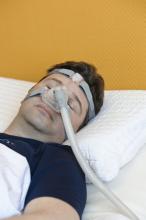according to results of a study.
In a retrospective observational study of 144 patients with obstructive sleep apnea, respiratory measures including apnea-hypopnea index (AHI), oxygen desaturation index, mean oxygen saturation, and Epworth Sleepiness scale scores did not differ between the two treatment groups at baseline and during a 12-month follow-up appointment. Treatment adherence was also similar between the two groups, reported Andrea Lanza of the Sleep Medicine Center at Niguarda Hospital in Milan, Italy, and coauthors in Sleep Medicine.
Patients received continuous positive airway pressure (CPAP) treatment between May 2012 and September 2014, and were assigned to one of two groups based on their choice of treatment. Initially, 102 opted for nasal pillows (Group P), and 42 chose the standard nasal mask (Group N). Patients who either changed masks or added a new one during titration or follow-up were assigned to a third group, Group C.
AHI did not differ significantly between groups at baseline or follow-up. In Group P, mean AHI at titration was 1.2 events per hour, compared with 1.8 in Group N and 1.9 in Group C (P = .109). At follow-up, AHI was 0.7 in Group P, 1.1 in Group N, and 0.9 in Group C (P = .172). Oxygen desaturation index and oxygen saturation also remained similar between the groups at baseline and follow-up, the investigators reported.
Additionally, long-term adherence did not differ significantly between the groups, with mean daily CPAP usage of 5.5 hours per night in Group P, 5.3 in Group N, and 5.6 in Group C. Mean usage was less than 4 hours per night for 11.6% in group P, 18.5% in group N, and 13.9% in group C, the authors added.
The frequency of side effects occurring in patients in two of the groups were similar (49% in Group P, vs. 61% in Group N; P = .212), though the nature of the side effects differed. Nostril pain or burning was reported only by patients in the nasal pillows group, and skin breakdown was reported only in the nasal mask group.
Though nasal pillows have typically been reserved for patients who do not tolerate the standard mask, the results of this study suggest that “nasal pillows could be safely prescribed as first-line interfaces,” the authors wrote. “They seem to be efficacious for CPAP titration and long-term treatment, ensuring a good rate of adherence.”
All of the authors reported having no disclosures.
SOURCE: Lanza A et al. Sleep Med. 2018 Jan;41:94-9



